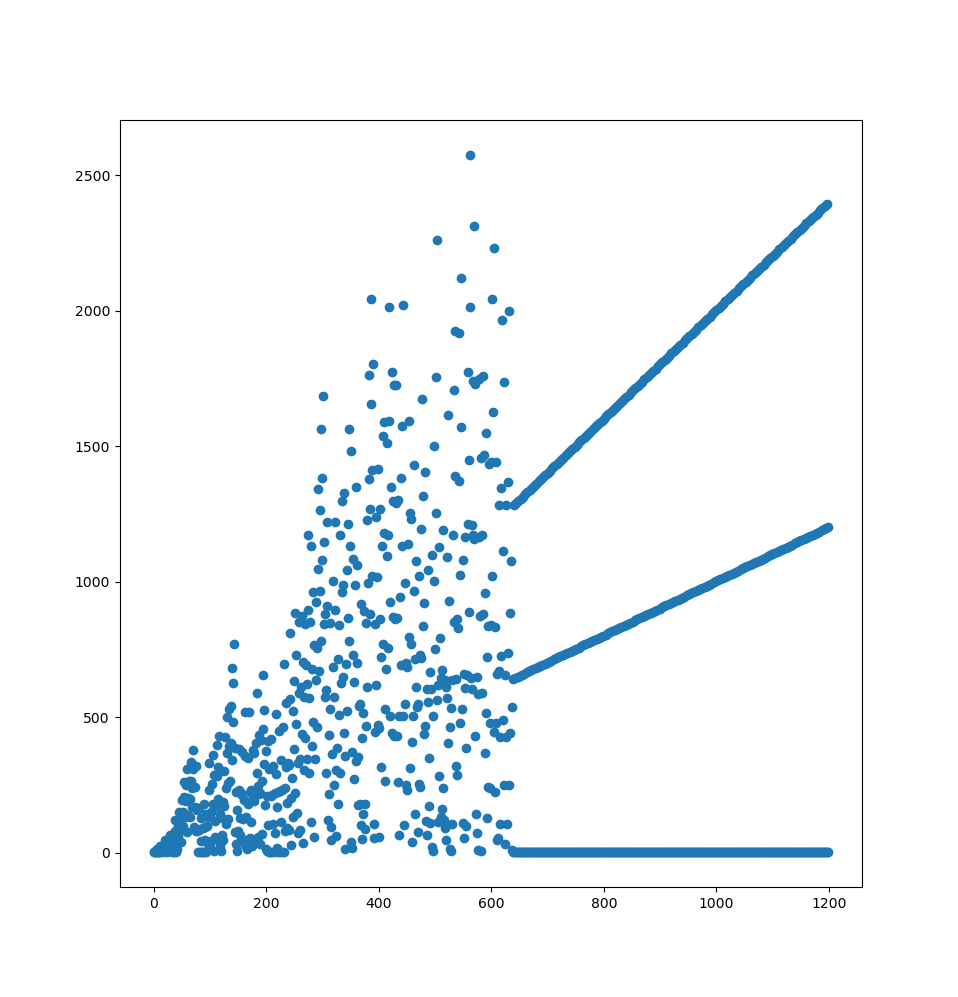实现OEIS中的一些整数序列。
项目描述
OEIS
项目
此项目是实现OEIS中的一些序列。
用法
要安装它,请运行:pip install oeis。
命令行使用
oeis可以从命令行使用
$ oeis --help
usage: oeis [-h] [--list] [--start START] [--stop STOP] [--plot] [--random] [--file] [--dark-plot] [sequence]
Print a sweet sequence
positional arguments:
sequence Define the sequence to run (e.g.: A181391)
optional arguments:
-h, --help show this help message and exit
--list List implemented series
--start START Define the starting point of the sequence.
--stop STOP End point of the sequence (excluded).
--plot Print a sweet sweet sweet graph
--random Pick a random sequence
--file Generates a png of the sequence's plot
--dark-plot Print a dark dark dark graph
需要特定的序列吗?
$ oeis A000108
# A000108
Catalan numbers: C(n) = binomial(2n,n)/(n+1) = (2n)!/(n!(n+1)!).
Also called Segner numbers.
[1, 1, 2, 5, 14, 42, 132, 429, 1430, 4862, 16796, 58786, 208012, 742900, 2674440, 9694845, 35357670, 129644790, 477638700, 1767263190]
懒惰?随机选择一个
$ oeis --random
# A000045
Fibonacci numbers: F(n) = F(n-1) + F(n-2) with F(0) = 0 and F(1) = 1.
[0, 1, 1, 2, 3, 5, 8, 13, 21, 34, 55, 89, 144, 233, 377, 610, 987, 1597, 2584, 4181]
想看些酷的东西吗?
$ oeis A133058 --plot --stop 1200
库使用
oeis模块将序列公开为Python序列
>>> from oeis import A000045
>>> print(*A000045[:10], sep=", ")
0, 1, 1, 2, 3, 5, 8, 13, 21, 34, 55
>>> A000045[1] == A000045[2]
True
>>> A000045[100:101]
[354224848179261915075]
贡献
我们使用black编码风格,并使用tox运行一些测试,因此创建一个venv并在其中安装tox后,运行tox -p auto它应该看起来像这样
$ tox -p auto
✔ OK mypy in 11.807 seconds
✔ OK flake8 in 12.024 seconds
✔ OK black in 12.302 seconds
✔ OK py37 in 15.344 seconds
✔ OK py38 in 21.041 seconds
✔ OK py39 in 21.042 seconds
______________________________________ summary ________________________________________
py37: commands succeeded
py38: commands succeeded
py39: commands succeeded
flake8: commands succeeded
mypy: commands succeeded
black: commands succeeded
congratulations :)
实现一个系列的两种方式:将其实现为函数,或将其实现为生成器。
从函数实现系列
对于结果只依赖于其位置的序列,如A004767,它是a(n) = 4*n + 3,作为函数来说非常直接,使用@oeis.from_function()作为装饰器来设置管道
@oeis.from_function()
def A004767(n: int) -> int:
"""Integers of a(n) = 4*n + 3."""
return 4 * n + 3
它具有快速直接访问的优势
print(A004767[1_000_000])
可以通过调用您的函数一次来完成。
注意:没有“偏移校正”是神奇地完成的。如果偏移是 1,不要期望你的函数在 n=0 时被调用。
从生成器实现序列
有些序列需要前一个(或前几个)值来计算,它们不能轻易地作为函数实现,你可以将它们作为生成器实现,在这种情况下使用 @oeis.from_generator() 装饰器
@oeis.from_generator()
def A000045() -> Iterable[int]:
"""Fibonacci numbers: F(n) = F(n-1) + F(n-2) with F(0) = 0 and F(1) = 1."""
a, b = (0, 1)
yield 0
while True:
a, b = b, a + b
yield a
注意:只需返回实际的序列值,不要在意偏移量,例如,尝试通过返回 None 或 0 来移动结果。
比较
所以,为了清楚起见,这两种实现是严格等价的
@oeis.from_generator()
def A008589() -> Iterable[int]:
"""Multiples of 7."""
return (n * 7 for n in count())
@oeis.from_function()
def A008589(n: int) -> int:
"""Multiples of 7."""
return n * 7
如果偏移量是1,只有生成器会从1开始(函数不需要改变,因为1会作为参数给出)
@oeis.from_generator(offset=1)
def A008589() -> Iterable[int]:
"""Multiples of 7."""
return (n * 7 for n in count(1))
为什么要求没有固定?
项目通常固定的有两种要求
- 实际项目依赖(numpy,...)。
- 测试依赖(pytest,...)。
无论如何,用户只是 pip install(或 apt install 或其他)项目并期望它工作。如果与依赖项存在不兼容性,我们需要知道它并在 install_requires 中明确限制。
固定项目依赖项是一种谎言:它在CI中有效,但在用户环境中可能无效。
固定测试依赖项看起来很舒适,就像测试今天通过明天也会通过一样,但这也意味着大多数时间都在运行过时的linters。
最后,固定依赖项可能根本不可能:可能不存在一组冻结的依赖项可以在你想要测试的每个Python版本上工作。
所以想法是:让我们不固定任何东西,在用户发现问题之前先从困难中学到问题。
是的,这意味着CI可能会随时崩溃。但比最终用户发现错误要好。
项目详情
下载文件
下载适用于您平台的项目文件。如果您不确定选择哪个,请了解有关 安装包 的更多信息。
















